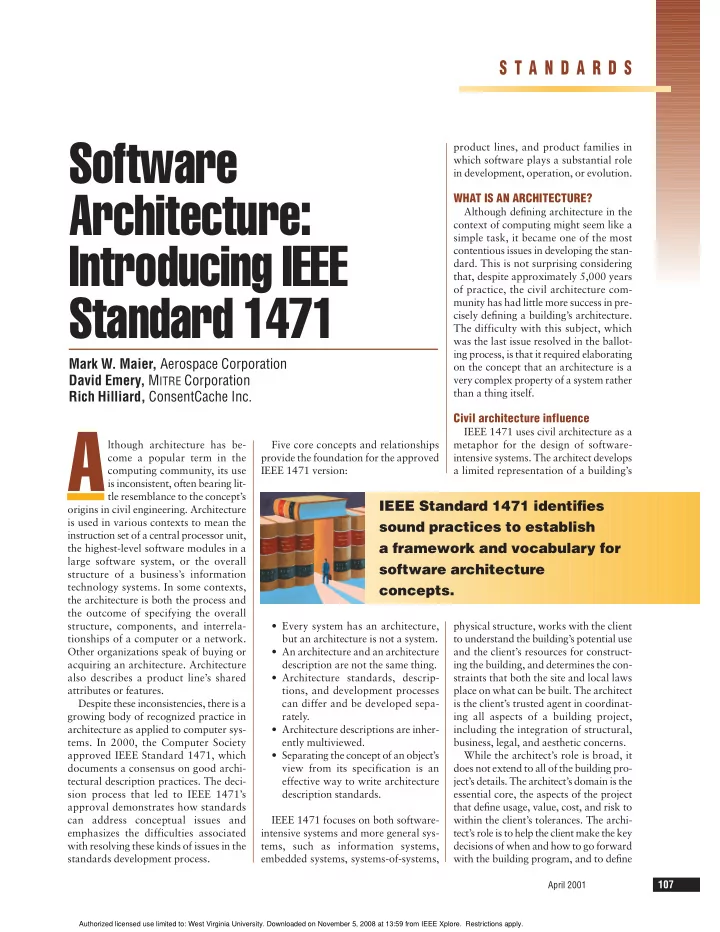

S T A N D A R D S Software product lines, and product families in which software plays a substantial role in development, operation, or evolution. Architecture: WHAT IS AN ARCHITECTURE? Although defining architecture in the context of computing might seem like a simple task, it became one of the most Introducing IEEE contentious issues in developing the stan- dard. This is not surprising considering that, despite approximately 5,000 years of practice, the civil architecture com- Standard 1471 munity has had little more success in pre- cisely defining a building’s architecture. The difficulty with this subject, which was the last issue resolved in the ballot- ing process, is that it required elaborating Mark W. Maier, Aerospace Corporation on the concept that an architecture is a David Emery, M ITRE Corporation very complex property of a system rather than a thing itself. Rich Hilliard, ConsentCache Inc. Civil architecture influence IEEE 1471 uses civil architecture as a A lthough architecture has be- Five core concepts and relationships metaphor for the design of software- come a popular term in the provide the foundation for the approved intensive systems. The architect develops computing community, its use IEEE 1471 version: a limited representation of a building’s is inconsistent, often bearing lit- tle resemblance to the concept’s IEEE Standard 1471 identifies origins in civil engineering. Architecture is used in various contexts to mean the sound practices to establish instruction set of a central processor unit, a framework and vocabulary for the highest-level software modules in a large software system, or the overall software architecture structure of a business’s information technology systems. In some contexts, concepts. the architecture is both the process and the outcome of specifying the overall structure, components, and interrela- • Every system has an architecture, physical structure, works with the client tionships of a computer or a network. but an architecture is not a system. to understand the building’s potential use Other organizations speak of buying or • An architecture and an architecture and the client’s resources for construct- acquiring an architecture. Architecture description are not the same thing. ing the building, and determines the con- also describes a product line’s shared • Architecture standards, descrip- straints that both the site and local laws attributes or features. tions, and development processes place on what can be built. The architect Despite these inconsistencies, there is a can differ and be developed sepa- is the client’s trusted agent in coordinat- growing body of recognized practice in rately. ing all aspects of a building project, architecture as applied to computer sys- • Architecture descriptions are inher- including the integration of structural, tems. In 2000, the Computer Society ently multiviewed. business, legal, and aesthetic concerns. approved IEEE Standard 1471, which • Separating the concept of an object’s While the architect’s role is broad, it documents a consensus on good archi- view from its specification is an does not extend to all of the building pro- tectural description practices. The deci- effective way to write architecture ject’s details. The architect’s domain is the sion process that led to IEEE 1471’s description standards. essential core, the aspects of the project approval demonstrates how standards that define usage, value, cost, and risk to can address conceptual issues and IEEE 1471 focuses on both software- within the client’s tolerances. The archi- emphasizes the difficulties associated intensive systems and more general sys- tect’s role is to help the client make the key with resolving these kinds of issues in the tems, such as information systems, decisions of when and how to go forward standards development process. embedded systems, systems-of-systems, with the building program, and to define April 2001 107 Authorized licensed use limited to: West Virginia University. Downloaded on November 5, 2008 at 13:59 from IEEE Xplore. Restrictions apply.
Recommend
More recommend